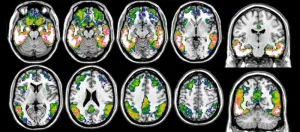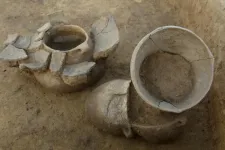(Press-News.org) Breastfeeding has long been used as a method to help keep newborns healthy and protected against a variety of diseases. But certain sugars naturally found in breastmilk could also help prevent infections before a baby arrives. Researchers reporting in ACS Central Science have found that these sugars can stop a common prenatal infection in human tissues and pregnant mice. This could someday help avoid preterm births or complications without the need for additional antibiotics.
One of the most common bacteria that can affect pregnancies is Group B streptococcus (GBS). If left untreated, GBS infections can potentially lead to adverse effects, including neonatal pneumonia or preterm birth. Though treatments are available, they primarily rely on antibiotics, which can give rise to resistant strains. However, many of the compounds already present in human breast milk, such as human milk oligosaccharides (HMOs), naturally have antibacterial effects. Previously, Steven Townsend, Jennifer Gaddy and colleagues explored the antimicrobial effects of HMOs, finding that they could inhibit growth of GBS in vitro and in certain reproductive cells. But before the compounds could be used to boost existing antibiotics or become a new therapeutic option entirely, researchers need to show how the sugars work in many tissues and in vivo. So now, the team wanted to investigate HMO activity in GBS infections in pregnant mice and human tissues.
The team first analyzed the protective effects of HMOs on human tissue infected with GBS, using both ex vivo fetal tissues and an organoid model of the vagina. When they added a mixture of HMOs designed to mimic the sugar composition in breast milk, the bacteria could not adhere and form colonies. The HMO mixture was then tested in pregnant mice infected with GBS. The treated mice had a relatively typical level of inflammation, reduced numbers of bacteria in several reproductive tissues, and experienced no instances of preterm births, ruptured membranes or maternal deaths. Taken together, these results demonstrate that HMOs can have antimicrobial effects without additional antibiotics. The researchers say that this work could allow for these sugars to be used as a viable therapeutic option to treat GBS infection and prevent adverse pregnancy outcomes.
The authors acknowledge funding from the National Science Foundation, the National Institutes of Health and the Department of Veterans Affairs.
The paper’s abstract will be available on Aug. 9 at 8 a.m. Eastern time here: http://pubs.acs.org/doi/abs/10.1021/acscentsci.3c00101
For more of the latest research news, register for our upcoming meeting, ACS Fall 2023. Journalists and public information officers are encouraged to apply for complimentary press registration by completing this form.
The American Chemical Society (ACS) is a nonprofit organization chartered by the U.S. Congress. ACS’ mission is to advance the broader chemistry enterprise and its practitioners for the benefit of Earth and all its people. The Society is a global leader in promoting excellence in science education and providing access to chemistry-related information and research through its multiple research solutions, peer-reviewed journals, scientific conferences, eBooks and weekly news periodical Chemical & Engineering News. ACS journals are among the most cited, most trusted and most read within the scientific literature; however, ACS itself does not conduct chemical research. As a leader in scientific information solutions, its CAS division partners with global innovators to accelerate breakthroughs by curating, connecting and analyzing the world’s scientific knowledge. ACS’ main offices are in Washington, D.C., and Columbus, Ohio.
To automatically receive news releases from the American Chemical Society, contact newsroom@acs.org.
Follow us: Twitter | Facebook | LinkedIn | Instagram
END
Sugars in breastmilk could help treat infections, prevent preterm births
2023-08-09
ELSE PRESS RELEASES FROM THIS DATE:
Human scent receptors could help ‘sniff out’ nerve gases in new sensor
2023-08-09
By some estimates, the human nose can detect up to a trillion different smells with its hundreds of scent receptors. But even just catching a quick whiff of certain chemicals known as nerve agents can be lethal, even in tiny amounts. Researchers now reporting in ACS Sensors have developed a sensitive and selective nerve gas sensor using these human scent receptors. It reliably detected a substitute for deadly sarin gas in simulated tests.
Nerve gases are often very potent, requiring highly sensitive sensors to detect them ...
Microplastics found in human heart tissues, both before and after surgical procedures
2023-08-09
Everywhere scientists look for microplastics, they’ve found them — food, water, air and some parts of the human body. But examinations of our innermost organs that aren’t directly exposed to the environment are still limited. Now, in a pilot study of people who underwent heart surgery, researchers in ACS’ Environmental Science & Technology report that they have found microplastics in many heart tissues. They also report evidence suggesting that microplastics were unexpectedly introduced during the procedures.
Microplastics ...
Electric car revolution puts Native communities at risk
2023-08-09
Conditions are ripe for an accelerated transition to electric vehicle (EV) use in the United States. The Biden-Harris administration has set a target that 50 percent of newly purchased cars in 2030 be electric. In addition, the Inflation Reduction Act of 2022 provides significant tax incentives for purchasing electric vehicles and for companies that produce them.
And that is good news for environmental justice (EJ), says Lisa Benjamin, author of a paper called “EVs as EJ?” forthcoming in Harvard Environment Law Review. Benjamin, associate professor of law at Lewis & Clark Law School, details all of the positive impacts of EVs ...
Tau-PET : a window into the future of Alzheimer’s patients
2023-08-09
Alzheimer’s disease, one of the most common neurodegenerative diseases, leads to progressive loss of memory and autonomy. It is characterised by the accumulation of neurotoxic proteins in the brain, namely amyloid plaques and tau tangles. Due to the silent development of pathology over decades, very early diagnosis is of utmost importance to be able to take action as early as possible in the disease process. A team from the University of Geneva (UNIGE) and the Geneva University Hospitals (HUG) has demonstrated ...
New research links early Europeans’ cultural and genetic development over several thousand years
2023-08-09
A new DNA study has nuanced the picture of how different groups intermingled during the European Stone Age, but also how certain groups of people were actually isolated. The study was carried out by researchers at Uppsala University working with an international team of researchers, who produced new genetic data from 56 Central and Eastern European individuals from the Stone Age. The results have been published in the journal Communications Biology.
“Conducting studies like this one requires a broad interdisciplinary discussion. In this study, this discussion has been exceptionally fruitful,” says Tiina Mattila, population geneticist at Uppsala ...
Natural gas odorants associated with consistent pattern of adverse health symptoms
2023-08-09
Odorants are widely used in natural gas for leak detection, however, few studies have examined their potential effects on public health. A new peer-reviewed publication in Current Environmental Health Reports, suggests that some commonly-used natural gas odorants may induce a range of adverse health symptoms at very low concentrations, ranging from headaches to respiratory inflammation and skin rashes.
“Our sense of smell is the first line of defense in detecting gas leaks, but few studies have examined how odorants in gas may adversely affect our health or well-being,” said the review’s lead author, PSE Healthy Energy Senior Scientist Drew Michanowicz. “The ...
Particulate air pollution a growing risk for premature CVD death and disability worldwide
2023-08-09
Research Highlights:
Between 1990 and 2019, the total annual number of premature CVD deaths and years of disability attributable to particulate matter air pollution rose by 31% worldwide.
The increase in deaths was unevenly distributed by sex, with a 43% increase in deaths among men compared to a 28.2% increase among women.
During the nearly 30 years of data reviewed, deaths and disability attributed to outdoor particulate matter pollution rose, while deaths associated with indoor use of solid fuels declined.
Regions ...
Over one million acres of tribal land submerged by dams in the US
2023-08-09
Dam constructions have flooded over 1.13 million acres of tribal land in the US contributing to the historic and ongoing struggle against land dispossession for Indigenous peoples in the United States. New research, published in Environmental Research Letters, has identified that a region of tribal land larger than the state of Rhode Island has been submerged by dams in the US. The findings raise concerns about the destruction of ecosystems, cultural heritage, and livelihoods.
The new study shows that dams have significantly contributed to land loss of Native people, a factor that ...
Does access to assisted suicide affect trends of conventional suicide among patients with cancer?
2023-08-09
An analysis published in Cancer Medicine reveals the trends of self-initiated deaths—including assisted suicide (AS) and conventional suicide (CS)—in Switzerland over a 20-year period, focusing on people who suffered from cancer. Although supporters of assisted dying state that access to AS should lead to a reduction in violent CS, the study’s findings do not confirm this assumption. The situations and motivations for cancer-associated CS seem to be clearly different from those for cancer-related AS.
In Switzerland, assisting in a suicide is not punishable as long as it does not serve selfish motives. ...
Researchers identify protein that may help protect against osteoporosis
2023-08-09
New research published in The FASEB Journal indicates that increasing the expression of a particular gene may help to prevent bone loss associated with postmenopausal osteoporosis.
For the study, investigators examined which genes are involved in turning precursor cells called bone marrow–derived mesenchymal stem cells (BMSCs) into cells that play a crucial role in bone formation. The screen identified a gene that encodes high mobility group AT-hook 1 (Hmga1), a protein that controls the expression of a variety of other genes.
In experiments conducted in rats, expression of Hmga1 increased during bone formation but decreased when rats’ ovaries were removed ...


